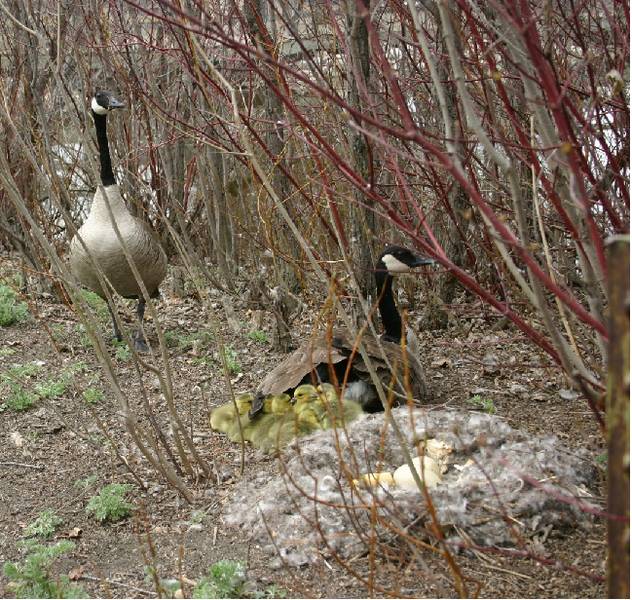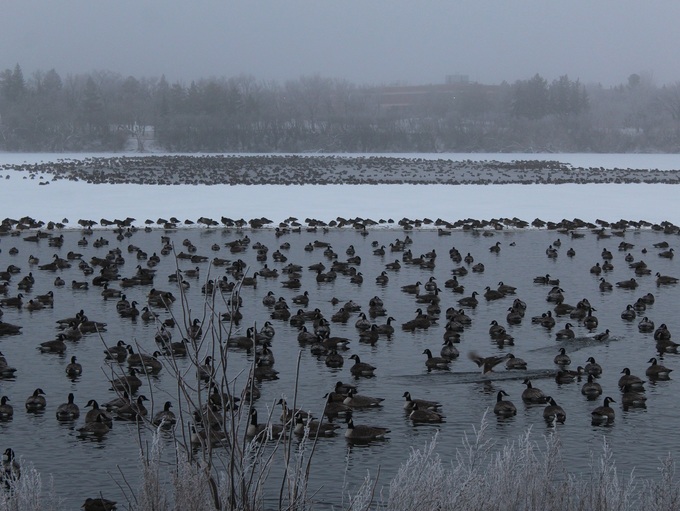A little about Canada Geese
Canada Geese arrive back to Wascana Centre usually around the middle of March. Pairs will quickly begin the process of making their nests and laying eggs after they arrive!
 Depending on the weather Canada Geese can begin laying eggs as early as the 27th of March! On average Canada Geese lay between 5-7 eggs but clutch size can range from 1-13 eggs. One of the most fascinating parts of Canada Geese behaviour is that the female will not begin incubation until she has laid all of her eggs. This ensures that all the chicks will develop at the same rate in the egg and hatch within hours of each other.
Depending on the weather Canada Geese can begin laying eggs as early as the 27th of March! On average Canada Geese lay between 5-7 eggs but clutch size can range from 1-13 eggs. One of the most fascinating parts of Canada Geese behaviour is that the female will not begin incubation until she has laid all of her eggs. This ensures that all the chicks will develop at the same rate in the egg and hatch within hours of each other.
The female will incubate these eggs for roughly 28-30 days at which time the young geese will hatch. The young birds will remain hidden under the female until all the young are dry (which can take up to 24 hours). At this time both the female and the male will escort the young birds to the water. The whole family will never return to the nest, although the adults may reuse the nest in subsequent years.
Unlike many other bird species, young Canada Geese are hatched able to forage on their own, so they do not rely on their parents to feed them. They do depend on them for protection from cold and rainy weather and predators.
The young grow quickly and at the age of 8-10 weeks are able to fly. Typically Canada Geese do not begin breeding until their 3rd or 4th year of life. So for the next few years they will wander in juvenile flocks. Young Canada’s will remain with their parents and siblings as they migrate south for their first winter and remain together for the entire winter. They may even return back to the parent’s breeding grounds in the spring. Once the parents begin breeding again, the yearlings presence will no longer be tolerated and they will be forced to move on.
During the fall, migrating Canada Geese from across Saskatchewan and even more northern areas will stop at Wascana Centre. As many as 10,000 birds will use Wascana as a resting stop. During the morning and evening, the birds will fly out to surrounding agricultural land and feed on leftover grain. During the middle of the day as well as the night, they will stay around Wascana Lake for protection.
Once the ice freezers over, usually in November, most of the geese will depart for warmer climates. If a small area of water is kept open (from aerators in the lake), a few dozen birds may overwinter here.
Once they decide to move, the majority of geese that breed in Wascana Centre spend their short winter (December to March) in South Dakota and Nebraska. Once it starts to warm up in March, they begin the cycle all over again!
Banding has shown that Canada Geese can have a surprisingly long life span. The oldest known banded Canada Goose in North America lived to be at least 33 years old! In Wascana Centre the oldest known banded bird was at least 16 years old.




with our newsletter